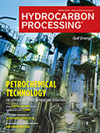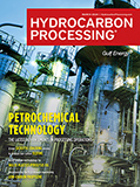Hydrocracking
Hydrocarbon Processing 2020 Awards WINNERS
<i>Hydrocarbon Processing</i>, the downstream processing sector’s leading technical publication, has announced the winners for its third annual awards.
Steam generator in a hydrocracker high-pressure loop—why not?
Historically, there has been a perception in the industry that it is not safe to include a steam generator in the high-pressure loop of a hydrocracker.
Business Trends
Rovuma LNG, a JV comprised of ExxonMobil, Eni and China National Petroleum Corp., will likely delay its final investment decision (FID) on the group’s $30-B Mozambique LNG project.
Octane enhancement avoiding both high reformer severity and alkylation
An innovative refinery process arrangementa converts butane-rich, light paraffinic streams—preferably containing a high proportion of isobutane—into butylene by dehydrogenation.
Optimization study in hydrocracker unit using simulation model
Hydrocrackers are key refinery units that convert heavy feed components into valuable lighter products. The profitability of these units is directly related to this conversion level. Conversion reactions take place in a nearly pure hydrogen environment, with the help of selective catalysts, under high pressure and high temperature. The products of the unit are separated in the fractionator section. Unconverted oil taken from the fractionator bottoms reveals the conversion performance of the unit.
HP Top Project Awards
The editors of <i>Hydrocarbon Processing</i> have identified nine projects that are anticipated to significantly impact the global or regional downstream industries. The winners and nominees of the HP Top Project awards will have a considerable impact on the HPI, whether through CAPEX, satisfying domestic or regional demand, diversifying product offerings, or adding to the resurgence in refining and/or petrochemical processing capacity.
Diversifying the future: Incentives for worldwide adoption of renewable fuels and chemicals—Part 2
Bio-based, renewable fuels and chemicals can reduce the environmental footprint of maintaining global transportation and product demands, while also offering supplementation of traditional fossil fuels in a global environment with increasing energy demand. The renewable energy sector is large and growing rapidly.
Hydrocarbon Processing Awards Winners
<i>Hydrocarbon Processing,</i> the downstream processing sector’s leading technical publication, has announced the winners for its third annual awards. The <i>HP</i> Awards celebrate innovative technologies and people that have been instrumental in improving facility operations over the past year.
Opportunity crudes and refinery challenges during hydrocracking operations—Part 2
Refineries worldwide often face practical challenges and operating issues when processing opportunity crude oils to maximize profit margins.
Opportunity crudes and refinery challenges during hydrocracking operations—Part 1
Refineries worldwide often face practical challenges and operating issues when processing opportunity crude oils to maximize profit margins.

- KBR's phenol technology selected by SABIC Fujian Petrochemicals 4/25
- Honeywell Technology helping to produce SAF with lower cost and waste 4/25
- Nigeria's NNPC partners local firm on new 100,000 bpd refinery 4/25
- Stranded cargo shows credit challenges at Nigeria's Dangote refinery 4/25
- Low U.S. distillate consumption reflects slow economic activity and biofuel substitution 4/25
- Clariant catalysts reduce customers’ footprints by 40 million tons of CO2e in 2023 4/25




